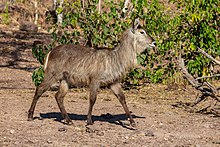| Waterbuck | |
|---|---|

| |
| Male K. e. defassa Queen Elizabeth National Park, Uganda | |

| |
| Female K. e. ellipsiprymnus Chobe National Park, Botswana | |
| Scientific classification | |
| Domain: | Eukaryota |
| Kingdom: | Animalia |
| Phylum: | Chordata |
| Class: | Mammalia |
| Order: | Artiodactyla |
| Family: | Bovidae |
| Genus: | Kobus |
| Species: | K. ellipsiprymnus
|
| Binomial name | |
| Kobus ellipsiprymnus (Ogilby, 1833)
| |
| Subspecies | |
|
See text | |

| |
| Distribution of subspecies of waterbuck | |
The waterbuck (Kobus ellipsiprymnus) is a large antelope found widely in sub-Saharan Africa. It is placed in the genus Kobus of the family Bovidae. It was first described by Irish naturalist William Ogilby in 1833. Its 13 subspecies are grouped under two varieties: the common or ellipsiprymnus waterbuck and the defassa waterbuck. The head-and-body length is typically between 177 and 235 cm (70 and 93 in) and the typical height is between 120 and 136 cm (47 and 54 in). In this sexually dimorphic antelope, males are taller and heavier than females. Males reach roughly 127 cm (50 in) at the shoulder, while females reach 119 cm (47 in). Males typically weigh 198–262 kg (437–578 lb) and females 161–214 kg (355–472 lb). Their coat colour varies from brown to grey. The long, spiral horns, present only on males, curve backward, then forward, and are 55–99 cm (22–39 in) long.
Waterbucks are rather sedentary in nature.[2] As gregarious animals, they may form herds consisting of six to 30 individuals. These groups are either nursery herds with females and their offspring or bachelor herds. Males start showing territorial behaviour from the age of 5 years, but are most dominant from the six to nine. The waterbuck cannot tolerate dehydration in hot weather, and thus inhabits areas close to sources of water. Predominantly a grazer, the waterbuck is mostly found on grassland. In equatorial regions, breeding takes place throughout the year, but births are at their peak in the rainy season. The gestational period lasts 7–8 months, followed by the birth of a single calf.
Waterbucks inhabit scrub and savanna areas along rivers, lakes, and valleys. Due to their requirement for grasslands and water, waterbucks have a sparse ecotone distribution. The IUCN lists the waterbuck as being of least concern. More specifically, the common waterbuck is listed as of least concern. while the defassa waterbuck is near threatened. The population trend for both is downwards, especially that of the defassa, with large populations being eliminated from certain habitats because of poaching and human disturbance.
- ^ IUCN SSC Antelope Specialist Group (2016). "Kobus ellipsiprymnus". IUCN Red List of Threatened Species. 2016: e.T11035A50189324. doi:10.2305/IUCN.UK.2016-2.RLTS.T11035A50189324.en. Retrieved 19 November 2021.
- ^ "Defassa Waterbuck Facts and Information | SeaWorld Parks & Entertainment". seaworld.org. Retrieved 2023-06-06.
